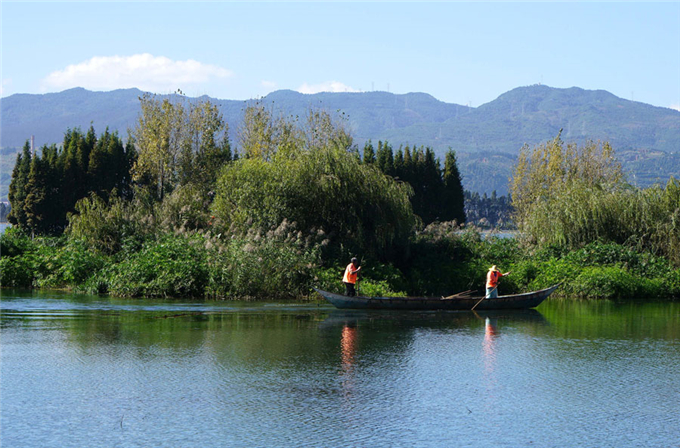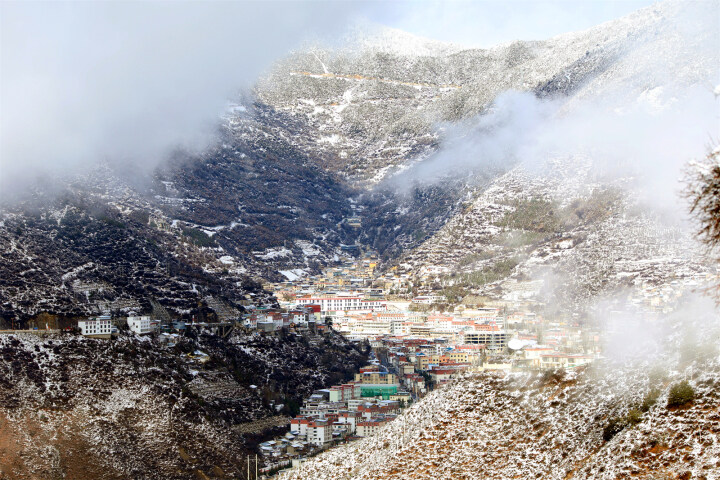Dianchi Lake, the biggest lake in Yunnan province, achieved its best water quality in at least three decades last year thanks to the local government's pollution control and ecological restoration efforts.

Two workers clear garbage from Dianchi Lake in Kunming, Yunnan province, in October. The lake's water quality last year was the best in at least three decades. [Photo/Xinhua]
Covering about 310 square kilometers in Kunming, the provincial capital, Dianchi Lake used to be one of the most polluted in the country because of the rapid local urbanization and industrialization process in the 1980s, according to Wu Zhaoyang, deputy director of the lake administration.
Wu said the city began its environmental monitoring of the lake in 1988. At that time, it didn't even reach the lowest Grade V standard in China's five-tier water quality assessment system.
The water of the lake has seen continuous improvement. After upgrading to Grade V in 2016, it further improved to Grade IV last year.
The improvement was measured after a series of steps were taken by local authorities. The governments of Kunming and Yunnan both published guidelines for the protection of the lake. The city government has one vice-mayor overseeing the governance of Dianchi Lake after a special government body was established in 2002 to manage it.
In addition to a drainage pipeline network that stretches 5,722 kilometers, another pipeline network of 96 km - which helps prevent waste water from entering the lake - has been built in the main urban area of Kunming and areas surrounding the lake, the administration said.
Many measures have also been taken in rural areas surrounding the lake and in rivers that feed it. Farms with 6.8 million animals (livestock and poultry) have been closed, and domestic wastewater from 885 villages that once had no sewage treatment facilities is now collected and treated, the administration said.
It added that local governments built 1,300 km of pipelines to help collect sewage along 116 rivers that feed the lake. And tailored pollution control plans were drafted for the 35 most important rivers, it said.
The administration warns, however, that lake pollution remains grim.
"The great damage to the water ecosystem resulted in an almost complete loss of biodiversity. With shallow water and limited self-purification capacity, it takes an extended period for the lake to get rid of its polluted water," it said, adding that a shortage of water resources also adds to the difficulties.
Huang Yuhong, chief engineer of the Dianchi Ecological Research Institute, said improvement of the lake water is a result of long-term efforts by both the provincial and city governments since 1985. The growing drainage pipeline network and the diversion of water from other basins are among the factors that have helped, Huang said.
She added that long-term plans are needed to clean up the lake.
"The ecosystem remains fragile and urgently needs restoration, which is a key part in the lake's treatment," Huang said. "But it takes a long time to reap the benefits."
China experienced marked improvement in its surface water quality last year.
According to the Ministry of Ecology and Environment, monitoring at 1,940 sites found that 71 percent of the water was at or above Grade III - a year-on-year improvement of 3.1 percentage points. Bodies of water listed below Grade V, the poorest quality, dropped by 1.6 percentage points to 6.7 percent.
Dianchi Lake still has mild pollution and eutrophication. Total phosphorus and chemical oxygen demand are still major problems, the ministry said.
|






7740f3b5-9ecb-438e-9052-76cb2d4bb671.jpg)

